Guided User Research Methods for Experience Design—A New Approach to Focus Groups and Cultural Probes
Abstract
1. Introduction
1.1. Existing User (Experience) Research Methods
- Clear focus on user experience
- Enable visual articulation of experiences
- Provide guidance for practical application e.g., in companies’ design teams
1.2. Augmentation of Existing User Research Methods with Focus on Experience, Guidance, and Creative Expression
1.3. Contribution of the Presented Work
2. Materials and Methods
2.1. Principles for Adaption of User Research Methods
2.2. Two-Step Approach for “Wicked Problems” within User Experience Research
2.2.1. Experience Focus Groups
- -
- Principle 1 and Principle 3: The experience focus groups extend the traditional method by dedicating the predefined phases especially to user experience research. As such, the experience focus group (see Table 2) contains, e.g., phases especially for the gathering of (positive) experiences of the participants (phase 3) and the generation of ideas for positive experiences as a base for following experience design (phase 5).
- -
- Principle 2 and Principle 3: The other phases of the experience focus group (1, 2 and 4) are dedicated to ensure a smooth introduction to a creative mindset and the topic of investigation. Although we propose a specific structuring for the experience focus groups, this structuring can be tailored to individual research questions. The structure consists of different phases and related tasks that can partly be rearranged if needed. Some phases can be omitted if they do not contribute to the research question at hand. However, it is strongly recommended to start with phases 1 “Conducting Warm-Up” and 2 “Setting Reference Points”, in order to ensure the smooth introduction to the topic and materials. Phases 3, 4 and 5 can be rearranged or even omitted as required by the topic and research questions for the experience focus group at hand. Each phase of the experience focus group consists of interactive tasks, which enable visual expression of the users’ experiences. The interactive tasks can be carried out either by individual participants, small groups or all participants together. Individual tasks are included to assure that all participants can equally take part in the discussion and contribute their experience and ideas. The defined structure with its specific interactive tasks and the change between individual and shared work of the participants supports the moderator of the discussion with time management and steering the group dynamics. Furthermore, while working on the tasks, participants already documented their results in a visual form, which allows the moderator to concentrate fully on the moderation of the experience focus group and significantly reduces the documentation and interpretation time of the generated materials afterwards.
2.2.2. Experience Probes
- -
- Principle 1 and 3: Structuring the survey into defined phases for more guidance of the users. The single phases of the experience probes involve specific tasks as described above in order to analyze the participants’ (positive) experiences and ideas for positive experience design regarding the study topic gradually. The resulting user study with experience probes lasts about one week and is composed of three main steps:
- ◦
- Introduction workshop (creative mindset, Introduction to visual materials, interactive tasks and general structure)
- ◦
- Fieldwork (individual/shared execution of interactive tasks)
- ◦
- Wrap-up workshop (discussion and shared analysis of the users’ visualized answers and experiences)
- -
- Principle 2: The traditional method of cultural probes already incorporates creative tasks for the participants to express their beliefs, desires and concerns in a creative way. However, the installation of a trustful atmosphere to enable for visual expression of the users’ experiences is missing. If the participants do not feel confident with the creative tasks, it is likely that they produce only few results or none at all, which cannot be controlled for in a longitudinal cultural probe study. This shortcoming is therefore addressed by the experience probes by the Introduction Workshop and dedicated phases of the fieldwork to become familiar with the materials and the study topic.
2.2.3. Analysis of Gathered Data
2.2.4. Case Study: A Practical Application and Evaluation of the Two-Step Approach
3. Results
3.1. Case Study Design and Methods
- -
- First, the term “family” is not predefined; it can have multiple meanings, e.g., depending on cultural context and social background;
- -
- second, the term ‘digital life’ is also a rather undefined, general expression, which is open to interpretations;
- -
- and third, there are multiple options to design positive experiences for “families and digital life” due to the nature of experiences and the need for radical innovations.
3.1.1. Step 1: Experience Focus Groups for the “Wicked Problem”: “Families and Digital Life”
- -
- to derive potential positives experiences within the merging field of the two topics “families and digital life” and cluster them;
- -
- to understand the different perspectives on the terms “family” and “digital life” as well as their influence on possible positive experiences; and
- -
- gather first ideas and concepts for the experience design of products and services as inspiration for the following ideation process
3.1.2. Step 2: Experience Probes for the “Wicked Problem”—“Families and Digital Life”
- -
- Primary school: two adults (female 40 years, male 44 years) three children (6, 9, and 11 years) (two of them in primary school).
- -
- Middle school: two adults (female 40 years, male 46 years), two children (9 and 12 years) (one of them in high school).
- -
- High school and university: two adults (female 50, male 51 years), two children (16 and 22 years) (either working or in university).
3.2. Case Study Results
3.2.1. Step 1: Results of Topic-Specific Experience Focus Groups
3.2.2. Step 2: Results of Topic-Specific Experience Probes
- -
- Positive Experience—Reassurance: Product to enhance the feeling of connection and trust in family relationships.
- -
- Positive Experience—Sharing: Shared family moments: Product to enable shared experiences for families.
- -
- Positive Experience—Sharing: Shared family decision: Service to enhance decisions within families, which every family member perceives as positive.
3.3. Case Study Evaluation: Practical Application of Experience Focus Groups and Experience Probes
- -
- The feasibility and efficiency of the two adapted methods within the context of user experience research; and
- -
- the usefulness of the methodological approach based on the three principles to find radical innovative ideas for products and services.
4. Discussion
Author Contributions
Funding
Acknowledgments
Conflicts of Interest
References
- Kahneman, D. Others objective happiness. Well Found. Hedonic Psychol. 1999, 3, 1–23. [Google Scholar]
- Spath, D.; Peissner, M.; Sproll, S. Methods from neuroscience for measuring user experience in work environments. In Proceedings of the International Conference on Applied Human Factors and Ergonomics (AHFE 10), Miami, FL, USA, 17–20 July 2010; USA Publishing: West Lafayette, IN, USA, 2010. [Google Scholar]
- Fronemann, N.; Peissner, M. User Experience Concept Exploration: User Needs as a source for innovation. In Proceedings of the 8th Nordic Conference on Human-Computer Interaction Fun, Fast, Foundational-NordiCHI ’14, Helsinki, Finland, 26–30 October 2014; ACM Press: Helsinki, Finland, 2014; pp. 727–736. [Google Scholar]
- Hassenzahl, M. The hedonic/pragmatic model of user experience. UX Manif. 2007, 10–14. Available online: https://www.academia.edu/2880396/The_hedonic_pragmatic_model_of_user_experience (accessed on 23 July 2020).
- Laib, M.; Burmester, M.; Ficano, C.; Fronemann, N.; Kolb, B.; Krüger, A.; Quesseleit, M.-L.; Schippert, K.; Shinkarenko, M. User Experience bei Softwareanbietern. In Mensch & Computer 2015 Proceedings; De Gruyter Oldenbourg: Berlin, Germany, 2015; pp. 93–102. [Google Scholar]
- Krüger, A.E.; Fronemann, N.; Peissner, M. Das kreative Potential der Ingenieure–menschzentrierte Ingenieurskunst. In Proceedings of the Stuttgarter Symposium für Produktentwicklung (SSP 2015) Entwicklung smarter Produkte für die Zukunft, Stuttgart, Germany, 19 June 2015; pp. 1–10. [Google Scholar]
- Rittel, H.W.; Webber, M.M. Wicked problems. Man-Made. Futur. 1974, 26, 272–280. [Google Scholar]
- Morgan, D.L. Focus groups. Annu. Rev. Sociol. 1996, 22, 129–152. [Google Scholar] [CrossRef]
- Kujala, S.; Minge, M.; Pohlmeyer, A.; Vogel, M. Temporal Aspects of User Experience: Models and Methods Beyond a Single Use Situation. 2012. Available online: https://www.semanticscholar.org/paper/Temporal-aspects-of-user-experience%3A-Models-and-a-Kujala-Minge/b05d0fd4166dea4ed59407552180ef4663ef3be5 (accessed on 23 July 2020).
- Rubin, J.; Chisnell, D.; Spool, J. Handbook of Usability Testing: How to Plan, Design, and Conduct Effective Tests; John Wiley & Sons Inc.: Hoboken, NJ, USA, 2011; ISBN 978-0-470-38608-8. [Google Scholar]
- Holtzblatt, K.; Wendell, J.B.; Wood, S. Rapid Contextual Design: A How-to Guide to Key Techniques for User-Centered Design; The Morgan Kaufmann series in interactive technologies; Elsevier/Morgan Kaufmann: San Francisco, CA, USA, 2005; ISBN 978-0-12-354051-5. [Google Scholar]
- Diefenbach, S.; Hassenzahl, M. Psychologie in der nutzerzentrierten Produktgestaltung; Springer: Berlin/Heidelberg, Germany, 2017. [Google Scholar]
- Yoon, J.; Desmet, P.M.; Pohlmeyer, A.E. Embodied typology of positive emotions: The development of a tool to facilitate emotional granularity in design. In Proceedings of the IASDR 2013: Proceedings of the 5th International Congress of International Association of Societies of Design Research “Consilience and Innovation in Design”, Tokyo, Japan, 26–30 August 2013; International Association of Societies of Design Research: Regensburg, Germany, 2013. [Google Scholar]
- Rafael, C.; Dorian, P. Wellbeing Determinant Cards. Posit. Comput. 2015. Available online: http://www.positivecomputing.org/p/were-pleased-to-share-some-of-tools-and.html (accessed on 23 July 2020).
- Kahneman, D.; Krueger, A.B.; Schkade, D.A.; Schwarz, N.; Stone, A.A. A survey method for characterizing daily life experience: The day reconstruction method. Science 2004, 306, 1776–1780. [Google Scholar] [CrossRef] [PubMed]
- Zeiner, K.M.; Laib, M.; Schippert, K.; Burmester, M. Identifying Experience Categories to Design for Positive Experiences with Technology at Work. In Proceedings of the 2016 CHI Conference Extended Abstracts on Human Factors in Computing Systems, San Jose, CA, USA, 7–12 May 2016; pp. 3013–3020. [Google Scholar]
- Laib, M.; Burmester, M.; Zeiner, K. Erlebnispotentialanalyse-Mit Systematik zu positiven Erlebnissen. In Mensch & Computer - 2017 Usability Prof.; Gesellschaft für Informatik e.V.: Regensburg, Germany, 2017. [Google Scholar]
- Zeiner, K.M.; Henschel, J.; Schippert, K.; Haasler, K.; Laib, M.; Burmester, M. Experience Categories in Specific Contexts–Creating Positive Experiences in Smart Kitchens. In Proceedings of the International Conference of Design, User Experience, and Usability; Springer International Publishing AG: Basel, Switzerland, 2018; pp. 306–324. [Google Scholar]
- Burmester, M.; Zeiner, K.; Schippert, K.; Platz, A. Creating positive experiences with digital companions. In Proceedings of the Extended Abstracts of the 2019 CHI Conference on Human Factors in Computing Systems, Glasgow, UK, 4–9 May 2019; pp. 1–6. [Google Scholar]
- Zeiner, K.M.; Laib, M.; Schippert, K.; Burmester, M. Das Erlebnisinterview–Methode zum Verständnis positiver Erlebnisse: Praktische Einführung und Diskussion von Implikationen zur UX-Gestaltungspraxis. In UP 2016; Gesellschaft für Informatik e.V. & German UPA e.V.: Aachen, Germany, 2016. [Google Scholar]
- Norman, D. The Design of Everyday Things Revised and Expanded Edition; Basic Books: New York, NY, USA, 2013; ISBN 978-0-465-07299-6. [Google Scholar]
- Sanders, L.; Stappers, P.J. Convivial Design Toolbox: Generative Research for the Front End of Design; BIS: Amsterdam, The Netherlands, 2012; ISBN 978-90-6369-284-1. [Google Scholar]
- Hassenzahl, M. User experience (UX): Towards an experiential perspective on product quality. In Proceedings of the IHM, Metz, France, 2–5 September 2008; Volume 8, pp. 11–15. [Google Scholar]
- Hassenzahl, M. Experience design: Technology for all the right reasons. Synth. Lect. Hum. Centered Inform. 2010, 3, 1–95. [Google Scholar] [CrossRef]
- Janssen, D.; Pollmann, K.; Fronemann, N.; Blank, D. Enabling SMEs to Conduct User Research: Experience with and Adaption of UX Concept Exploration. In Proceedings of the International Conference on Applied Human Factors and Ergonomics; Springer: Basel, Switzerland, 2019; pp. 445–456. [Google Scholar]
- Gaver, B.; Dunne, T.; Pacenti, E. Design: Cultural probes. Interactions 1999, 10, 21–29. [Google Scholar] [CrossRef]
- Gaver, W.W.; Boucher, A.; Pennington, S.; Walker, B. Cultural probes and the value of uncertainty. Interact 2004, 11, 53–56. [Google Scholar] [CrossRef]
- Kitzinger, J. Qualitative research: Introducing focus groups. BMJ 1995, 311, 299–302. [Google Scholar] [CrossRef] [PubMed]
- Krüger, A.E.; Peissner, M.; Fronemann, N.; Pollmann, K. BUILDING IDEAS: Guided Design for Experience. In Proceedings of the 9th Nordic Conference on Human-Computer Interaction; ACM: New York, NY, USA, 2016; pp. 115:1–115:6. [Google Scholar]
- Krüger, A.E.; Kurowski, S.; Pollmann, K.; Fronemann, N.; Peissner, M. Needs profile: Sensitising Approach for User Experience Research. In Proceedings of the 29th Australian Conference on Computer-Human Interaction-OZCHI ’17, Brisbane, Australia, 28 November–1 December 2017; ACM Press: Brisbane, Australia, 2017; pp. 41–48. [Google Scholar]
- Kelley, T.; Kelley, D. Creative Confidence: Unleashing the Creative Potential within Us All; William Collins: London, UK, 2013; ISBN 978-0-00-751797-8. [Google Scholar]
- Plattner, H.; Meinel, C.; Weinberg, U. Design-Thinking; Springer: Berlin/Heidelberg, Germany, 2009. [Google Scholar]
- Kristiansen, P.; Rasmussen, R. Building a Better Business. Using the Lego Serious Play Method; Wiley: Hoboken, NJ, USA, 2014; ISBN 978-1-118-83245-5. [Google Scholar]
- IDEO. Commercial the Field Guide to Human-Centered Design; Design Kit, 2015; Available online: https://www.designkit.org/resources/1 (accessed on 23 July 2020).
- Franke, T.; Attig, C.; Wessel, D. Assessing Affinity for Technology Interaction–The Affinity for Technology Interaction (ATI) Scale. Unpublished manuscript. 2017. [Google Scholar]
- Myers, M.D. Qualitative Research in Business and Management; Sage Publications Limited: New York, NY, USA, 2019. [Google Scholar]


| Method | Description | Deficiencies |
|---|---|---|
| Traditional user research methods e.g., [10] | E.g., focus groups, interviews, surveys, ethnographic methods. | Traditional usability methods have their origin in social sciences and/or classic usability-engineering and, thus, haven not an inherent focus on the users’ experience. |
| Contextual Inquiries [11] | Field interviews conducted with users, e.g., in their workplaces while they work. Thereby the user researchers are observing and inquiring into the users’ perspective. | The contextual inquiries are traditionally designed to analyze the users’, activities, tools, and flows at their workplace. The primary focus is on understanding the processes and the requirements by obtaining information that are not always conscious to the user. |
| Need Cards [12] | The need cards are based on the user experience model [23,24], which sets the fulfillment of basic human needs as base for a positive UX. The need cards contain a brief description as well as typical feelings, visualizations and quotes for seven relevant psychological needs. The need cards are created to provide orientation and inspiration when designing products that aim at evoking positive experiences in the user. | The need cards do not involve guidance on how to apply them, e.g., in user experience research, except for just reading them. Therefore, it is possible that, when need cards are solely used, the needs may still appear abstract and theoretical, especially in design teams with a predominant usability mindset. |
| UX Concept Exploration [3,25] | The method consist of three phases: I. Concept briefing (users get to know the product or service concept), II. Field phase (users imagine the usage of the presented concept, evaluate and extend it regarding basic user needs), III. Analysis workshop and expert evaluation regarding the fulfillment of basic needs by the promoted concept. | The execution of UX concept exploration requires a fundamental understanding of the psychological needs model for user experience. Furthermore, it requires UX experts for the evaluation of the resulting ideas and concepts. |
| Experience Interview [20] | Narrative-Interview to prompt users about positive experiences and specific aspects regarding those. The Experience Interview can be conducted in two ways: prompting the user openly about positive experiences in specific contexts; prompting the user about specific positive experiences in specific contexts. | The experience interview is designed to prompt individual users about their experiences. Thus, it does not allow for, e.g., controversial group discussions as required for step 1 of our approach. Furthermore, it merely builds on the verbal or written articulation of the users’ experiences. |
| Experience Categories [16,18,19] | Experience categories are a methodology aimed at understanding existing and creating new positive experiences. The categories describe aspects of positive experiences for specific contexts, which can be, e.g., used in analysis workshops or as a starting points for ideation. | The experience categories exist only for specific contexts (e.g., work environments and kitchens). |
| Experience Potential Analysis [17] | The experience potential analysis enables a creative process aimed at the identification of potentials for a positive user experience design. The method and its creative process is based on the experience categories [16]. | The experience potential analysis exists only for specific contexts (e.g., work environments and kitchens). |
| The day re-construction method [15] | The participants construct a short diary of the previous day. Thereby they are asked to divide this day into specific episodes (e.g., commuting to work) and estimate their durations. Then, the participants are questioned regarding specific aspects about their experience during the episode. | Merely builds on the users’ verbal or written articulation of their experiences. |
| Co-creation Methods [15] | The participants are enabled to immerse in and express their experiences during, e.g., a workshop session with the aid of visual materials. | The co-creation methods are missing systematic guidance for long-term surveys of experiences. Furthermore, the focus is not explicitly on the survey of hedonic aspects of the users’ experience. |
| Cultural Probes [26,27] | Cultural probes enable the users to record their answers to a given research topic with artifacts such as postcards, cameras and diaries. | The cultural probes are missing merely a guidance for a systematic survey of experiences. Instead, the results serve rather as a creative inspiration for designers. |
| Phase | Goals and Aims | Duration |
|---|---|---|
| 1 Conducting Warm Up | Becoming acquainted with one another and the study topic; creation of a pleasant, trustful, and creative atmosphere. | 15 min |
| 2 Setting Reference Points | Individual tasks that help the participants to reflect on their personal views and current situation regarding the study topic. Thus, all further reflections on potential positive experiences and product design aspects can be related to one’s own current situation, making discussions more lively and graspable. | 30 min |
| 3 Gathering User (Experience) Requirements | Individual or group tasks to identify user requirements for future solutions, especially potentials for additional positive experiences. | 45 min |
| 4 Inspiring Experiential Impulses | Concretion or defined restriction of the solution space by an impulse regarding the content of the user experience research study topic (e.g., presentation of existing product or service solutions) as well as an active familiarization and experiencing of the presented content for the participants. | 30 min |
| 5 Generating Ideas and Concepts for positive Experiences | Individual or group tasks to develop ideas and visions for positive user experience design or extend existing solutions for products and services (within the study topic) regarding positive experiences. | 30 min |
| Phase | Goals and Aims | Duration |
|---|---|---|
| 0 Gathering User (Experience) Requirements Encompassing task for the total duration | Repeated (e.g., daily) individual or group task to identify user requirements for future solutions, including user needs and potentials for additional positive experiences. | 10 min |
| 1 Conducting Warm Up | Individual task; set up of an informal, creative atmosphere; introduction to the study topic; identification of positive experiences. | 10 min |
| 2 Defining Current Experiences | Individual task that allow the participants to familiarize with the study topic and the status quo of the momentary behavior becomes transparent for the further work on the study topic during the cultural probes. | 30 min |
| 3 Reflecting Personal Views | Individual task for the reflection of personal views regarding the study topic as reference points for the further research process. | 30 min |
| 4 Reflecting Peers Views | Individual task for the reflection of personal views of other users as reference points for further study process; gathering of additional insights about the users’ view on and relation to the study topic. | 30 min |
| 5 Imagining Positive Experiences | Individual task; relevant psychological needs and potential positive experiences are gathered by describing a hypothetic situation or vision, which includes positive aspects of the study topic. | 30 min |
| 6 Taking Experiential Perspectives | Individual task; potential positive experiences and relevant needs are gathered through user description of hypothetic situations or visions, which includes positive aspects of the study topic. | 30 min |
| Phase | Tasks and Materials | Example Raw Data |
|---|---|---|
| 1 | Task 1—Evolution Game: As a warm-up, participants were engaged in playful and activating interaction situations with one another that also includes physical activity. In this particular experience focus group, this was realized by a game called Evolution. In this game, participants walk around the room, acting out a certain life stage (baby, school kid, parent, grandparents). Everyone starts as a ‘baby’. When meeting another ‘baby’, they play rock, paper and scissors—the winner proceeds to the next level and now acts out a ‘school kid’. The goal is to win often enough to arrive at the last stage ‘grandparent’. While the game could be played with any evolutionary stages, the ‘life stages’ were chosen to not only activate participants, but also already prepare them for the topic of the study. Task 2—Intuitive Gesture: Each participant was asked to make a gesture to express what family means for her, accompanied by an explaining statement. Materials: Game rules | Task 2—Intuitive Gesture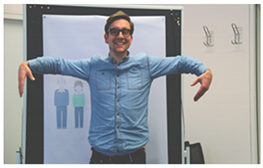 “family is…always fun” 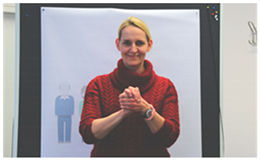 “ family is…being tight together” |
| 2 | The reference points were set with two individual tasks that were then shared with the group. Task 1—Stakeholder Map: As a first task, participants were asked to construct a stakeholder map that showed all persons they understand as their family; including a short description of their relationship and age. Participants could also vary the distance between the representation of themselves and each family member, by placing stickers on a template accordingly. Task 2—Family Animal: To uncover important aspects of the concept of family, participants were asked to build a fictitious animal with Lego® bricks that represents the characteristics of their family that matters most to them. Materials: Template and stickers for the stakeholder map, Lego® bricks | Task 1—Stakeholdermap This participant indicated the closest “family“—connection to his flat mates (who were not relatives). Task 2—Family Animal 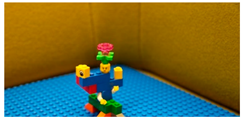 Lego® model representing a participant’s family as an animal: Most important characteristic of family: “Many different people forming a unity through me”. |
| 3 | The user (experience) requirements were explored from two different angles, representing the two concepts that shall ultimately be combined in an interactive product or service as the goal of this case study: family and use of digital products. Task 1—Shared family experiences: In a silent brainstorming participants collected experiences that bind them together with their family. The experiences were then shared with the group, clustered on a poster and discussed with the focus on elaborating on why these experiences are perceived as positive. Task 2—Digital experiences: In a silent brainstorming, participants wrote down experiences they frequently have with digital devices and members of their family. They then put these experiences on a digital journey map—a poster that outlines the 24 h of a full day. Thus, the experiences could be related to specific time points during a day. Again, the experiences were discussed among the group. Materials: Post-its, digital journey map poster | Task 1—Shared (family) Experiences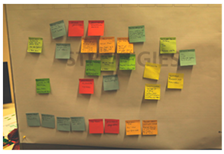 Shared Family Experience from the Silent Brainstorming, clustered on a poster. Task 2—Digital Experiences 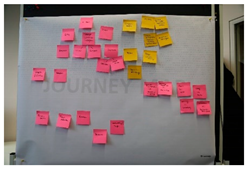 Digital Journey Map including all experiences with digital devices throughout the day. |
| 4 | Task—Vision family life 2050: In groups of three, participants were instructed to build a model of their (positive) vision of family life in the year 2050 using Lego® bricks. These models can point towards potentials of positive experience in future products and services for families. Material: Lego® bricks | Task—Vision Family Life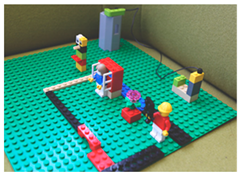 Lego® model depicting one group’s vision: increased distance between family members is bridged by technology: miniaturized and fast communication devices; larger screens for video calls; 4D device to cook and season meals together; communication robot for “lazy communicators” |
| Phase | Tasks and Materials | Example Raw Data |
|---|---|---|
| 0 | Family Heatmap: Group task for the whole family to be completed each day throughout the week. The family members were asked to track their individual usage of digital devices as well as their shared usage, which they perceive as significant experiences. Our aim was to get an overview over shared experiences as a family and individual experiences regarding the domestic space. Materials: Poster with stickers (icons for activities and devices, colors and symbols per person and day). | Ongoing task—Family Heatmap The family indicated their floor plan of the house. On this day the main family activities were in the kitchen and living room, the daughter was extensively using her electronic devices also in her own room. |
| 1 | Experience Snapshots: Individual task to take a picture of the first and last person the participant saw, favorite technical device, favorite place and most beautiful moment of the day (adults, children). Our aim was to set up an informal, creative atmosphere; and an introduction of the study topic. Furthermore, we wanted to identify positive experiences. Materials: Personal smartphone camera (adults, children). | Task—Experience Snapshot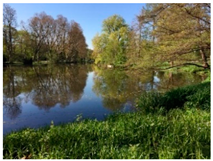 “A sunny day” favorite moment of one participant. |
| 2 | Digital Experience: Individual task; document digital devices used and the frequency throughout the day.
Our aim was for each participant to measure the own usage of digital devices and get a deeper understanding of their own digital behavior. Materials: Timeline template with a legend to track their usage of digital devices (adults). Piece of paper and colored pens (children). | Task—Digital Experience (adult) 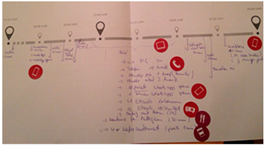 The timeline shows the usage of digital devices throughout the day. “It also enabled the participants to reflect their own behavior,” mentioned a participant. Task—Digital Experience (child)  Drawing of one child showing the devices used during the day. Even devices, such as the heating system, were mentioned. |
| 3 | Personal Role of technology: “Which role does technology play in your life?” Individual task, participants were asked to reflect their personal digital (daily) life. Our aim was the reflection of personal views on the study topic. Materials: Small bag of Lego® bricks | Task—Personal view of technologies’ role in life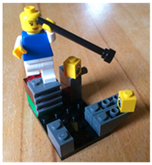 Lego® model displaying the own perception of technology used. Digital devices are understood as helpful devices to organize the family life, therefore, it is easier to keep a good overview (symbolized by the telescope). |
| 4 | Role of Technology for Peers: “How do other family members interact/ behave with technology?” Individual task, participants were asked to reflect how other family members use their digital devices. Our aim was to reflect the own perception of the behavior with digital devices of other family members. Through the change of perspective the own perception should be broadened. Materials: Lego® bricks | Task—Peers view of technologies’ role in life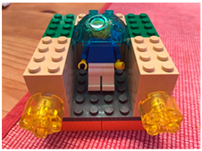 Lego® model displaying how an adult perceived their teenage child-self-isolated through their smartphone usage. |
| 5 | Taking Time Off: Individual task to write and draw (adults) or draw (children) a story about a family day trip. Our aim was to gather potential positive experiences through the description of a hypothetic situation or vision, which includes positive aspects of the study topic. Materials: Piece of paper and colored pens | Task—Taking Time Off (adult)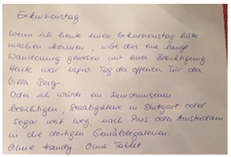 Description of a family day trip. Interesting result, the participant was wishing for no digital devices during the day. Instead they wanted to spend time together visiting a museum or going on a long hike. |
| 6 | Taking Experiential Perspectives: “If you were a child again—how would look your room today?”—draw your desired room (adult) “When I grow up…”—draw or build a Lego® model (child) Our aim was to experience the topic from the perspective of a different family member. Materials: Piece of paper and colored pens (adults), piece of paper and colored pens, Lego® (children). | Task—If you were child again… (adult)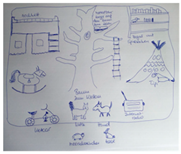 Drawing of an adult showing how the desired kids’ room would look like. Only an Internet radio is mentioned everything else is analogue. |
© 2020 by the authors. Licensee MDPI, Basel, Switzerland. This article is an open access article distributed under the terms and conditions of the Creative Commons Attribution (CC BY) license (http://creativecommons.org/licenses/by/4.0/).
Share and Cite
Krueger, A.E.; Pollmann, K.; Fronemann, N.; Foucault, B. Guided User Research Methods for Experience Design—A New Approach to Focus Groups and Cultural Probes. Multimodal Technol. Interact. 2020, 4, 43. https://doi.org/10.3390/mti4030043
Krueger AE, Pollmann K, Fronemann N, Foucault B. Guided User Research Methods for Experience Design—A New Approach to Focus Groups and Cultural Probes. Multimodal Technologies and Interaction. 2020; 4(3):43. https://doi.org/10.3390/mti4030043
Chicago/Turabian StyleKrueger, Anne Elisabeth, Kathrin Pollmann, Nora Fronemann, and Beatrice Foucault. 2020. "Guided User Research Methods for Experience Design—A New Approach to Focus Groups and Cultural Probes" Multimodal Technologies and Interaction 4, no. 3: 43. https://doi.org/10.3390/mti4030043
APA StyleKrueger, A. E., Pollmann, K., Fronemann, N., & Foucault, B. (2020). Guided User Research Methods for Experience Design—A New Approach to Focus Groups and Cultural Probes. Multimodal Technologies and Interaction, 4(3), 43. https://doi.org/10.3390/mti4030043





